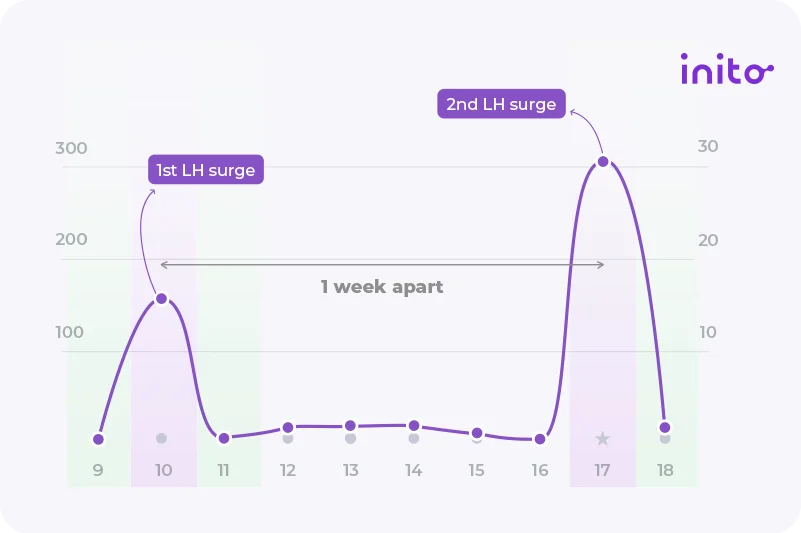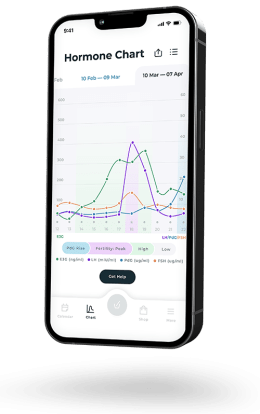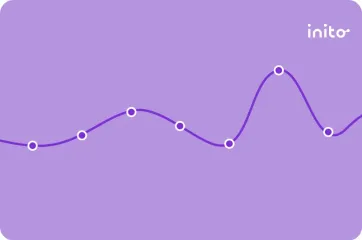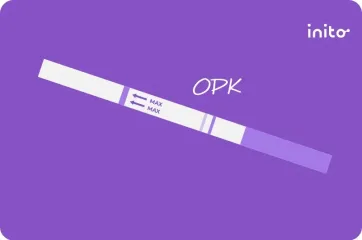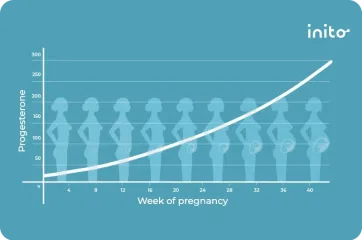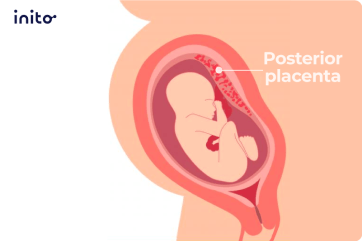Content table
Are you getting continuous positives on your OPKs a week apart in the same cycle?
Believe it or not, it’s actually not that unusual to have two LH surges. In fact, 33% of cycles have a double surge, and 8% of cycles have more than two surges.
Hang around to better understand double LH surges and the nitty-gritty of ovulation.
Key Takeaways
- Two LH surges in one cycle can happen. It means that your ovulation test picked up on two distinct rises in the luteinizing hormone.
- Tracking your LH helps predict when ovulation is about to occur. You will ovulate about 24 – 36 hours after the initial spike in LH.
- Two LH surges in one cycle can happen for a few reasons. These include double surges, multiple surges, and PCOS.
- An LH surge does not confirm ovulation. But tracking your LH alongside PdG (urine metabolite of progesterone) can help track and confirm ovulation.
- Inito’s fertility monitor can give you more accurate data about your ovulation than most at-home OPKs. This is because Inito tests LH, PdG, and two other hormones all in one strip.
- Using the most accurate tracking devices can be helpful in having a successful fertility journey and ultimately achieve pregnancy.
What Is a Double LH Surge?
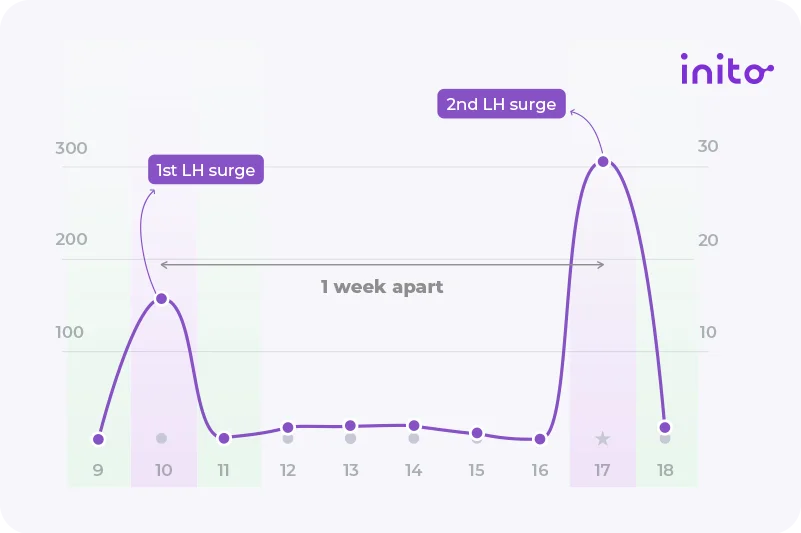
To begin, let’s review what an LH surge is. During the follicular phase of your cycle, it’s the luteinizing hormone’s job to trigger the ovary to release an egg.
Your LH will “surge” to act as this trigger. A surge is basically a noticeable spike in LH. And it usually happens about 24-36 hours before ovulation.
Some women may actually experience more than one LH surge though (aka a double surge). This means that your LH levels spiked twice in the same cycle. On an ovulation test, this would mean you see a darker test line on two separate occasions.
So how do you track your LH surge to mark your ovulation?
Tracking LH Surges
Tracking your LH surges can be a helpful way to predict your most fertile days when done correctly. This is because you will typically ovulate between 24 and 36 hours after the onset of the LH surge or 8 – 20 hours after the LH peak.
LH surges are tricky to monitor because you can have changes in LH surge patterns from one menstrual cycle to the next. On top of that, some LH surges can happen very quickly (rapid surge). Others can happen over the course of a few days (gradual onset surge). This makes it difficult to track multiple LH surges.
Are Multiple LH Surges Normal?
Yes, this is normal. If you are ovulating each cycle, having more than one LH surge is nothing to worry about. More than likely, a double LH surge or multiple LH surges will only happen for you occasionally.
People used to think double LH surges in one cycle were out of the norm. But research shows that double surges are actually much more common than we thought.
Recent research also shows that LH surges vary from cycle to cycle and woman to woman. This makes it difficult to say whether or not certain types of LH surges are “normal” or “abnormal.” But here are some numbers to put this into perspective for you.
In one study, researchers found that 33% of the cycles showed two LH surges (or a double peak). This means that there were two separate LH surges several days apart.
In another study, 44% of the women experienced fluctuating LH surges. These included double peaks, post-peaks, pre-peaks, or small peaks.
Let’s understand why this may be happening!
Why Am I Having a Second LH Surge?
If you go by what traditional textbooks say, you may think it’s only normal to have a single rapid LH surge. But that is simply not the case. Actually, only 48% of cycles follow this LH surge pattern. The remaining 52% of cycles will have other various surge patterns.
You may have a second LH surge because the first surge may not have been adequate enough. Your body probably needed a higher dose of LH surge to cause ovulation.
And while your body tries its best to ovulate, the LH surge patterns may vary each time.
These other variants could be the cause for having a second LH surge. Here are some of the possibilities:
Double LH Surge
A double LH surge happens when you have a second LH peak in one cycle. This is absolutely normal. However, this could also be caused by irregular cycles or hormonal imbalances.
Sometimes the first spike in luteinizing hormone may not be high enough to trigger your ovary to release an egg. Don’t worry; it doesn’t indicate that something is wrong. It’s your body’s way of ensuring an egg is released.
Double LH surges are completely normal. They happen in 33% of cycles. Your body didn’t respond to the first trigger for whatever reason and needs another reminder.
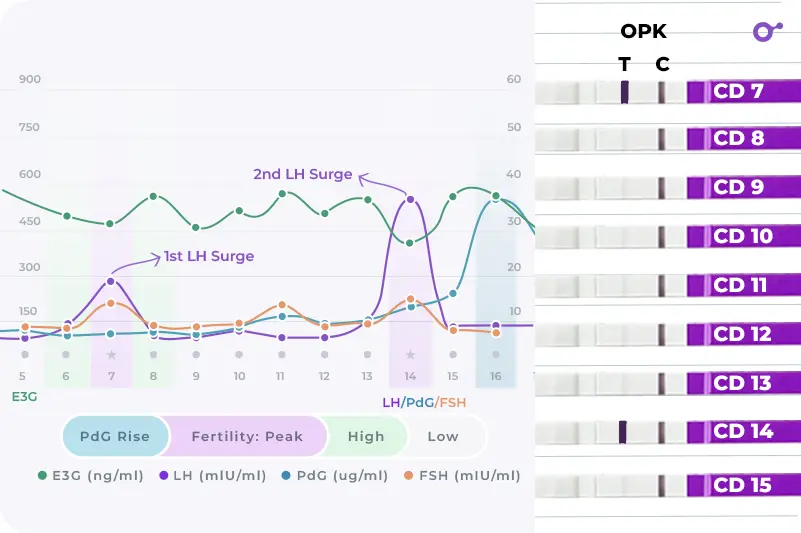
Tracking with OPKs
When you use an OPK, it measures your LH using an average threshold. This is usually around 25 mIU/ml. So if you have a double LH surge type above this threshold, you could get false positives on multiple days when using an OPK.
Test lines can cause confusion, showing false LH surges. And you may not be able to accurately track your true LH surge.
If you look at the image above, for the OPK, you will see a positive test line on CD 7 and CD 14. But you wouldn’t know which one was the true surge.
Tracking with Inito
Inito measures your actual hormone values and plots them on easy-to-understand charts. The Inito monitor allows you to track your daily LH values so you can have a better picture of your fertile window. Plus, you can observe the two LH surges one week apart.
The Inito graph below shows the two LH surges on the chart for CD 7 and CD 14. But you also see the confirmed ovulation on CD 17 with the rise in PdG. This extra information shows that CD 7 was not the actual surge. It was CD 14.

See How Your Hormone Chart Might Look Like!
Answer some questions to help us provide you a free personalized hormone chart customized to your hormonal health and conditions
Multiple LH Surges
If you have more than two LH surges during a single menstrual cycle, that is considered multiple LH surges. Most of the time, these surges are completely normal. They happen about 8% of the time.
Sometimes though, multiple surges can signal hormonal regulation disorders or other medical conditions like Polycystic Ovary Syndrome (PCOS) or anovulatory cycles. If you have an anovulatory cycle even after having multiple LH surges, that is a cause for concern.
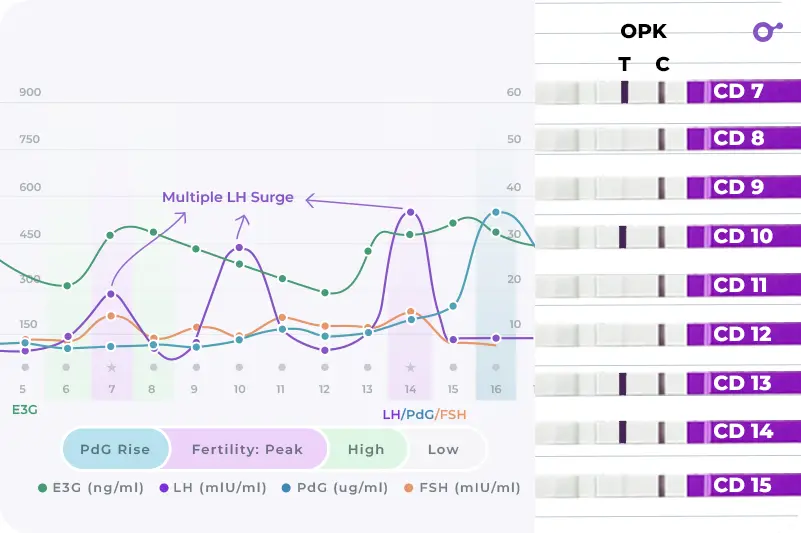
Tracking with OPKs
You will get multiple positive results. But you won’t be able to confirm which one triggered ovulation, if any.
In the image of the OPK, you see there was a positive test line CD 7, CD 10, CD 13, and CD 14. There is no way for you to know which one of these 4 surges was the true surge that caused ovulation.
Tracking with Inito
In the image of the Inito graph, you also see the LH surges for those same four days. However, you also see that ovulation was confirmed on CD 17 because of the rise in PdG. So this tells you that the true surge happened between CD 13 and CD 14 as opposed to the first two surges.
PCOS (Polycystic Ovary Syndrome)
Women with PCOS have LH levels that rise and fall frequently in the same cycle. Having PCOS makes it difficult to rely on regular ovulation tests. This condition causes you to have higher LH levels throughout your whole cycle. This makes it difficult to determine the true LH surge.
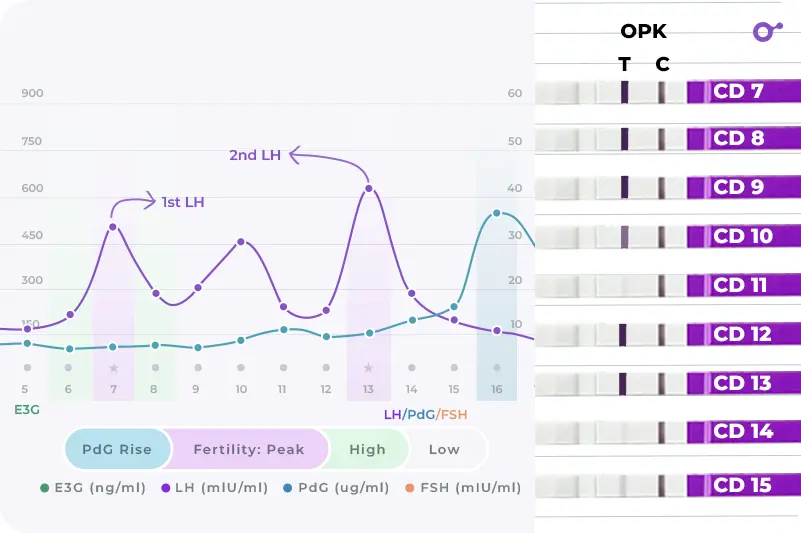
Tracking with OPKs
Your LH levels are continually high. Since they are above the average threshold, you will get multiple false positives throughout the whole cycle. In the OPK image above, you see there are LH surges show up for more than half of the days shown. You see positive test lines on cycle days 7, 8, 9, 10, 12, and 13. This makes it very challenging to tell which one triggered ovulation.
Tracking with Inito
In the Inito chart, you see LH peaks for days 7, 8, 9, 10, 12, and 13. But you also see the actual values of your hormone levels. This helps you get more accurate data to track your fertile window. You can see a rise in PdG that confirms ovulation on CD 18. This means that the true LH surge was on CD 12 or CD 13 and not the first surge on CD 7.
With so many LH surges, which one should you consider the actual surge? Read on to find out!
How to Determine the True LH Surge?
The best way is by tracking the rise in your progesterone or PdG (the metabolite of progesterone). Progesterone and its metabolite PdG rise only after you ovulate. This is because, after ovulation, the corpus luteum begins releasing progesterone. So, the true LH surge will be the one that’s soon followed by a rise in progesterone and its metabolite PdG.
How Does Inito Help Track the True LH Surge?
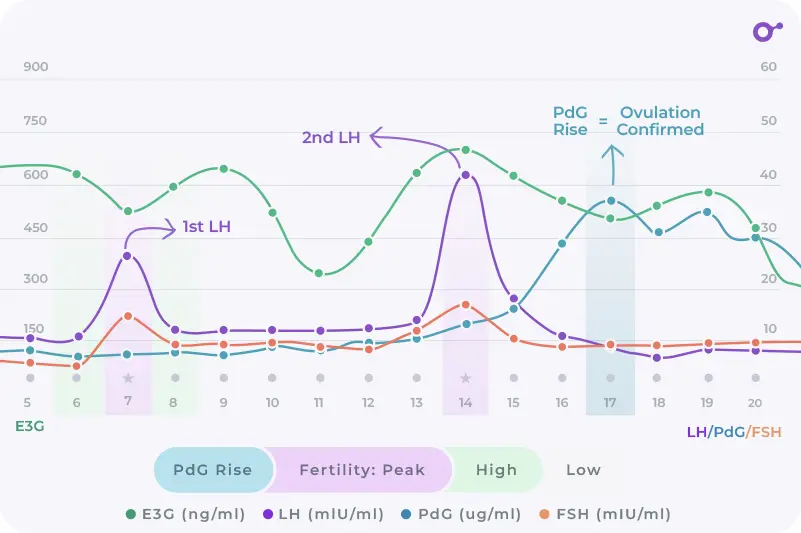
Unlike OPKs, Inito’s fertility monitor tracks PdG levels which helps confirm ovulation! Inito’s strips test all four sex hormones on a single strip that you insert into the monitor.
The monitor will tell you that you have peak fertility when your LH levels rise. It confirms ovulation when your PdG levels rise. The LH surge after which the PdG rise occurred is the true LH surge.
These very specific peak fertility readings make timed intercourse more effective. This also tells you the actual values for each of the four hormones. And the best part? This information is readily available at your fingertips just by connecting the Inito app to your smartphone.

FAQs
There are two main things you should do when monitoring two LH surges. First, tracking your cycle accurately. The kit and test you use matter. Second, measure your PdG levels after each surge.
Doing these two things will give you more accurate data about your ovulation. And keep in mind that there can be multiple reasons for having two LH surges. So if you are concerned you may have an underlying health condition like PCOS, make sure to see your doctor.
This is possible. However, this is likely to occur only if you have a hormonal imbalance or a medical condition such as PCOS. In a normal cycle, your LH levels will drop after ovulation. If there is another LH surge, then you may have likely not ovulated during the first surge.
Nope! Your LH levels are fairly low when you are pregnant. But if you take an LH test while pregnant, you could get a faint line on the test. This is because of cross-reactivity between LH and hCG (human chorionic gonadotropin). The alpha subunits of LH and hCG are identical. And most ovulation kits test for the alpha subunit of LH. So, an LH testing strip could easily mistake hCG for LH.
You can have two LH surges in one cycle a few days apart. In a study that tracked 107 women for 3 cycles, researchers found that 33% of the cycles showed two LH surges. The length of days between surges varied. So, it is normal to have two LH surges in a cycle. As long as you are ovulating, it’s all good.
This is more common than most people realize! Back in the day, it was thought that all women had a single LH surge pattern. But some women have a double surge or multiple surge pattern, meaning that their LH levels spike two or more times in the same cycle. This may happen if the initial LH surge wasn’t enough to trigger ovulation, and it’s nothing to be worried about. In fact, 33% of cycles have a double LH surge pattern.
Some women have multiple LH surges in the same cycle. Around 8% of cycles have more than two LH surges. That said, if you have consistently fluctuating LH levels, it could be a sign of a hormonal imbalance called polycystic ovary syndrome (PCOS). PCOS causes women to have higher-than-normal LH levels and levels that vary unpredictably throughout their cycle.
Nope! The exact LH level doesn’t indicate higher quality ovulation. What’s more important is the timing of ovulation within your cycle and the fact that your LH levels surged high enough to trigger ovulation in the first place.
You can expect to ovulate between 24 and 36 hours after the start of your LH surge or around 8 – 20 hours after your LH peak.
Was this article helpful?
- Luteinizing hormone surge in normally ovulating women – Fertility and Sterility
- Mean versus individual hormonal profiles in the menstrual cycle – Fertility and Sterility
- Relationships between the luteinizing hormone surge and other characteristics of the menstrual cycle in normally ovulating women – Fertility and Sterility
- Ovulation detection in the human
- Urinary Luteinizing Hormone Tests: Which Concentration Threshold Best Predicts Ovulation? – PMC
- Detection of ovulation, a review of currently available methods – PMC




